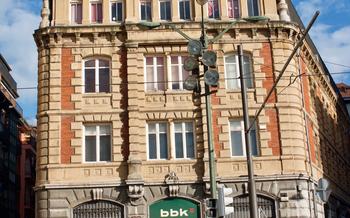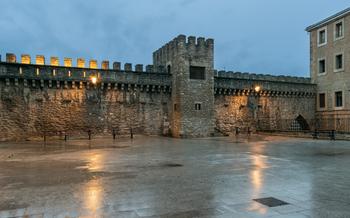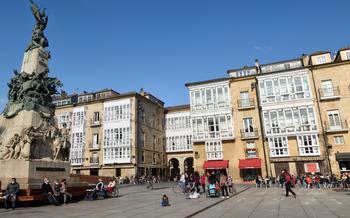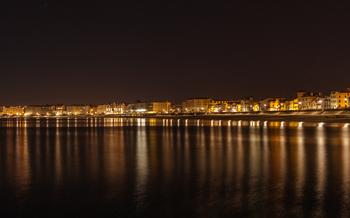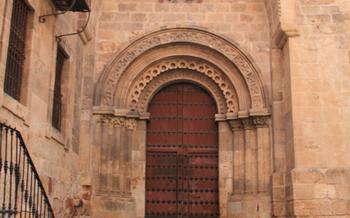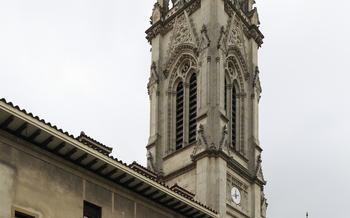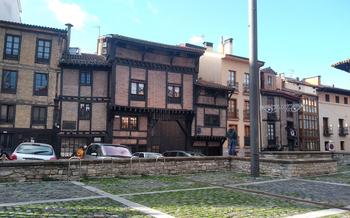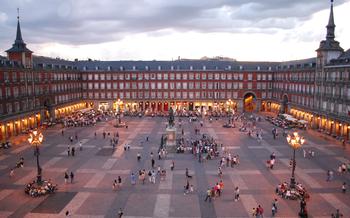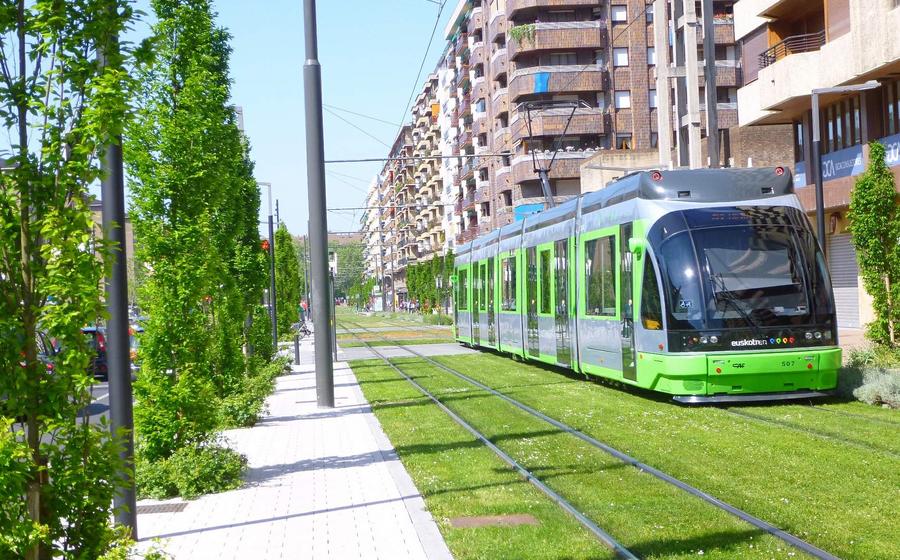
Antezana de Foronda (historic village)
- Antezana de Foronda: A Hidden Gem in the Basque Country
- Strolling Through Antezana's Charming Streets
- Visiting the Antezana de Foronda Palace
- Exploring the Church of San Martín
- Discovering the Hermitage of Santa Ana
- Strolling Along the Ebro River
- Exploring the Antezana de Foronda Natural Park
- Indulging in Local Cuisine
- Shopping for Local Crafts
- Attending Local Festivals and Events
- Getting Active in Antezana de Foronda
- Taking a Day Trip to Nearby Cities
- Insider Tip: Discovering Hidden Gems
Antezana de Foronda: A Hidden Gem in the Basque Country
Nestled in the heart of the Basque Country, Antezana de Foronda is a charming village that has managed to retain its medieval essence. Its rich history, unique traditions, and stunning natural surroundings make it a hidden gem waiting to be explored.
History: Unveiling the Rich Past of the Village
Antezana de Foronda's history dates back to the Middle Ages when it was part of the Kingdom of Navarre. During this period, the village was a strategic defensive point due to its location on the border with Castile. Its strategic position attracted many battles and sieges, which left their mark on the village's architecture and culture.
Culture: Exploring the Village's Unique Traditions and Festivals
Antezana de Foronda is renowned for its vibrant culture, which is deeply rooted in Basque traditions. The village is home to several annual festivals, including the Festival of San Martín in November, which features traditional Basque music, dance, and food. The village's unique traditions, such as the "bertsolaris" (improvised singers), reflect the Basque people's rich oral tradition.
Architecture: Admiring the Village's Well-Preserved Medieval Buildings
Antezana de Foronda is a living testament to medieval architecture. Its well-preserved buildings, such as the Antezana de Foronda Palace and the Church of San Martín, showcase the village's rich architectural heritage. The village's narrow cobblestone streets, lined with traditional Basque houses, transport visitors back in time.
Nature: Discovering the Stunning Natural Surroundings
Antezana de Foronda is surrounded by breathtaking natural landscapes. The Ebro River, which flows through the village, provides a tranquil setting for walks and picnics. The Antezana de Foronda Natural Park, located just outside the village, offers diverse ecosystems, including forests, meadows, and wetlands, which are home to a variety of flora and fauna.
Strolling Through Antezana's Charming Streets
Antezana de Foronda's cobblestone streets beckon travelers to embark on a journey through time. Each step reveals a hidden gem, a testament to the village's rich history and enduring spirit. The medieval walls whisper tales of ancient battles and conquests, while the intricately carved doorways hint at the lives and loves of generations past.
History: Discover the fascinating stories behind the village's ancient walls. Uncover the legends of brave knights, pious monks, and cunning merchants who once walked these very streets.
Culture: Immerse yourself in the vibrant atmosphere of Antezana de Foronda, where tradition and modernity seamlessly intertwine. Join the locals for a leisurely stroll, savor the delicious aromas wafting from family-run bakeries, and soak in the infectious energy of lively plazas.
Architecture: Capture the essence of Antezana de Foronda's architectural heritage through your lens. Photograph the picturesque houses with their colorful facades and intricate balconies. Gaze in awe at the majestic churches, their spires reaching towards the sky, and marvel at the intricate details of the town hall, a symbol of civic pride.
Nature: Find tranquility and rejuvenation amidst the village's tranquil surroundings. Breathe in the fresh air, scented with the fragrance of wildflowers, and listen to the gentle murmur of the nearby river. Escape the hustle and bustle of modern life and embrace the serenity of Antezana de Foronda.
Visiting the Antezana de Foronda Palace
The Antezana de Foronda Palace is a magnificent Renaissance-style building that dominates the village's skyline. Constructed in the 16th century, the palace was once the residence of the powerful Antezana family. Today, it serves as a cultural center and hosts various events, exhibitions, and concerts throughout the year.
History: - Explore the palace's rich history and learn about its former inhabitants, the Antezana family, who played a significant role in the village's development. - Discover the palace's architectural evolution over the centuries, from its original construction in the 16th century to its restoration in the 19th century.
Culture: - Attend cultural events, exhibitions, and concerts held at the palace, showcasing local and international artists and performers. - Immerse yourself in the village's vibrant cultural scene by participating in workshops, lectures, and other cultural activities organized at the palace.
Architecture: - Marvel at the palace's impressive Renaissance-style facade, adorned with intricate carvings and sculptures. - Step inside the palace to admire its grand interior, featuring elegant rooms, a stunning staircase, and a beautiful courtyard. - Capture the palace's architectural beauty through photography, capturing its unique details and perspectives.
Nature: - Stroll through the palace's beautifully landscaped gardens, offering a tranquil oasis amidst the village's historic streets. - Relax in the gardens, surrounded by colorful flowers, manicured lawns, and shady trees, enjoying the peaceful atmosphere.
Exploring the Church of San Martín
History
The Church of San Martín stands as a testament to the enduring legacy of Antezana de Foronda's rich past. Its foundations were laid in the 12th century, during a period of profound religious devotion and architectural innovation. The church's construction spanned several decades, with each era leaving its distinct mark on the structure. Visitors can trace the evolution of architectural styles, from the Romanesque origins to the Gothic additions that lend the church its distinctive character.
Culture
The Church of San Martín serves as a vibrant hub for the village's religious and cultural life. Throughout the year, the church hosts a variety of religious ceremonies, festivals, and events that bring the community together. During Semana Santa (Holy Week), the church becomes the epicenter of solemn processions and reenactments that commemorate the Passion of Christ. These events offer a glimpse into the deep-rooted Catholic traditions that have shaped the village's cultural identity.
Architecture
The Church of San Martín is a masterpiece of Gothic architecture, showcasing the skill and artistry of medieval builders. Its exterior features intricate stone carvings, delicate tracery, and soaring buttresses that lend the structure a sense of grandeur. Inside, visitors are greeted by an awe-inspiring vaulted ceiling, supported by graceful columns adorned with intricate capitals. The church's stained-glass windows, depicting biblical scenes and saints, bathe the interior in a kaleidoscope of colors, creating an atmosphere of serenity and contemplation.
Nature
The Church of San Martín is nestled amidst a tranquil natural setting, surrounded by lush greenery and the gentle murmur of a nearby stream. The church's serene location invites visitors to pause and appreciate the beauty of the surrounding landscape. From the church's courtyard, visitors can enjoy panoramic views of the village and the rolling hills beyond, a reminder of the harmonious coexistence between nature and spirituality.
Discovering the Hermitage of Santa Ana
Unraveling the Legends Surrounding the Hermitage
Nestled amidst the picturesque hills around Antezana de Foronda lies the enchanting Hermitage of Santa Ana. This secluded sanctuary is steeped in mystery and legend, captivating the imaginations of visitors and locals alike. As you approach the hermitage, you'll be mesmerized by its unique architectural style, a blend of Romanesque and Gothic influences that exudes a sense of timelessness.
According to local lore, the hermitage was built on the site where Saint Anne, the mother of the Virgin Mary, appeared to a shepherdess in the 12th century. The shepherdess, guided by a divine vision, discovered a miraculous spring that possessed healing properties. Word of the spring's miraculous powers spread like wildfire, attracting pilgrims from far and wide who sought solace and healing.
Over the centuries, the Hermitage of Santa Ana became a popular destination for religious pilgrimages. Devotees would flock to the hermitage, seeking divine intervention and paying homage to Saint Anne. The hermitage's reputation as a place of miracles grew, and it became a symbol of hope and faith for the people of Antezana de Foronda.
To this day, the Hermitage of Santa Ana remains a place of pilgrimage and devotion. Every year, on the feast day of Saint Anne, a colorful procession winds its way through the village, culminating at the hermitage. Pilgrims gather to celebrate the saint's life and to seek her blessings, continuing a tradition that has endured for centuries.
Strolling Along the Ebro River
The Ebro River, a majestic waterway that has shaped the history and culture of Antezana de Foronda, meanders through the village, adding to its charm and tranquility. Take a leisurely stroll along the riverbank, breathing in the fresh air and enjoying the picturesque views. Learn about the river's role in shaping the village's history, from its use as a trade route to its role as a source of water and power.
Admire the medieval bridge that spans the river, a testament to the village's rich architectural heritage. Cross the bridge and find a spot to relax and enjoy a picnic or barbecue with friends and family. As you soak in the tranquility of the river, watch the birds soar overhead and listen to the gentle sound of the water flowing.
For a more active experience, rent a kayak or canoe and paddle along the river, exploring its hidden coves and tranquil stretches. Anglers will delight in casting their lines into the river's waters, hoping to catch a glimpse of the local fish species. Whether you choose to stroll, cycle, or paddle, the Ebro River offers a serene and scenic escape from the hustle and bustle of everyday life.
Exploring the Antezana de Foronda Natural Park
History The Antezana de Foronda Natural Park is a protected area located just outside the village of Antezana de Foronda. The park's diverse ecosystems are home to a variety of flora and fauna, including several endangered species. The park was established in 1997 to protect the area's natural beauty and ecological significance.
Culture The park is a popular destination for nature lovers and outdoor enthusiasts. Visitors can enjoy hiking, biking, and horseback riding through the park's varied landscapes. There are also several guided nature walks and workshops offered throughout the year.
Architecture In addition to its natural beauty, the park is home to several historical and cultural landmarks. Visitors can explore ancient dolmens and menhirs, which are prehistoric megalithic structures. The park is also home to several old mills and waterwheels, which were once used to power the local economy.
Nature The Antezana de Foronda Natural Park is a haven for wildlife. Visitors can spot a variety of birds, including eagles, hawks, and owls. The park is also home to several species of mammals, such as deer, wild boar, and foxes. The park's diverse ecosystems provide a home for a wide variety of plants, including wildflowers, ferns, and mosses.
Indulging in Local Cuisine
Antezana de Foronda is a culinary paradise, offering a tantalizing array of traditional Basque dishes that will delight even the most discerning palate. The village's restaurants and taverns serve up a symphony of flavors, showcasing the freshest local ingredients and centuries-old recipes.
Indulge in the succulent flavors of pintxos, bite-sized snacks that are a staple of Basque cuisine. These culinary creations, often served on small slices of bread, burst with bold flavors, from the classic gildas (anchovies, olives, and pickled peppers) to the innovative croquetas de jamón (ham croquettes).
For a hearty meal, savor the marmitako, a traditional fish stew made with tuna, potatoes, and red peppers, a dish that reflects the village's close ties to the sea. Meat lovers will relish the chuleta de vaca, a grilled rib steak, or the alubias con sacramentos, a hearty bean stew with sacramental meats.
Sweet tooths will find solace in the village's pastel vasco, a delicious cake filled with custard or fruit, or the goxua, a layered dessert made with sponge cake, custard, and whipped cream. These sweet treats are the perfect ending to a memorable meal in Antezana de Foronda.
To fully immerse yourself in the local culinary culture, participate in a cooking class and learn the secrets of Basque cuisine from local experts. These classes offer a hands-on experience, allowing you to create your own pintxos or traditional dishes under the guidance of skilled chefs.
Don't miss the opportunity to visit the village's weekly market, where you can find an array of fresh produce, artisanal cheeses, and homemade pastries, all showcasing the bounty of the Basque countryside.
Shopping for Local Crafts
Antezana de Foronda is renowned for its vibrant artisanal traditions, offering a treasure trove of unique crafts and souvenirs for visitors to cherish. The village is home to a thriving community of skilled artisans and craftsmen who pour their heart and soul into creating beautiful handmade products. From intricate ceramics and pottery to delicate lace and textiles, each piece tells a story of the village's rich cultural heritage.
Visiting the local craft workshops and galleries is a must for any traveler seeking authentic souvenirs. Here, you can meet the artisans themselves, learn about their techniques, and witness their passion for their craft firsthand. Many workshops offer hands-on experiences, allowing visitors to try their hand at pottery, weaving, or other traditional crafts.
The village's annual craft fair is a highlight of the local calendar, attracting artisans from across the region. This lively event showcases a diverse range of handmade goods, from traditional Basque handicrafts to contemporary designs. It's a wonderful opportunity to browse, shop, and support the local artisans while immersing yourself in the vibrant atmosphere of the village.
When shopping for local crafts in Antezana de Foronda, be sure to look for items made from natural materials, such as wood, leather, or wool. These sustainable and eco-friendly products not only reflect the village's commitment to preserving its natural surroundings but also make for unique and meaningful souvenirs.
Whether you're looking for a special gift for a loved one or a memento of your travels, Antezana de Foronda offers an abundance of locally crafted treasures that will transport you back to this charming village and its rich artisanal traditions.
Attending Local Festivals and Events
Antezana de Foronda comes alive during its many local festivals and events. These celebrations offer a glimpse into the village's rich cultural heritage and provide a chance to experience the vibrant atmosphere of the community.
The most famous festival is the Fiesta de San Juan, held on June 24th. This festival celebrates the summer solstice and features a colorful parade, traditional Basque music and dancing, and a grand fireworks display.
Another popular event is the Medieval Market, held in August. During this festival, the village is transformed into a medieval marketplace, with vendors selling traditional crafts, food, and beverages. Visitors can also enjoy historical reenactments, jousting tournaments, and live music.
Throughout the year, Antezana de Foronda hosts various other festivals and events, including religious processions, music concerts, and sporting competitions. These events are a great way to meet the locals, learn about their customs, and immerse yourself in the village's festive spirit.
Insider Tip: For a truly authentic experience, be sure to try the local cuisine during the festivals. Many vendors sell traditional Basque dishes, such as pintxos, marmitako, and txakoli wine.
Getting Active in Antezana de Foronda
Antezana de Foronda boasts a rich sporting heritage, offering visitors ample opportunities to stay active and embrace the village's vibrant sporting culture. Whether you're an avid athlete or simply seeking a leisurely outdoor pursuit, the village has something to offer everyone.
History: Uncovering the Sporting Heritage
Antezana de Foronda's sporting roots can be traced back to the early 20th century when the village became a hub for Basque pelota, a traditional Basque sport that combines elements of tennis and handball. The village's pelota court, located in the heart of the village, has hosted countless tournaments and matches over the years, attracting players and spectators from across the region.
Culture: Joining Local Sports Clubs and Teams
For those eager to immerse themselves in the local sporting culture, Antezana de Foronda offers a variety of sports clubs and teams that welcome visitors with open arms. From football and basketball to cycling and hiking, there's a club or team to suit every interest and skill level. Joining a local team is a fantastic way to meet new people, make friends, and experience the camaraderie that comes with team sports.
Architecture: Using the Village's Sports Facilities
Antezana de Foronda is well-equipped with modern sports facilities that cater to a wide range of sporting activities. The village boasts a state-of-the-art sports center with indoor and outdoor facilities, including a swimming pool, gym, tennis courts, and a multi-purpose sports field. These facilities are open to the public and offer a great opportunity to stay active and healthy while enjoying the village's beautiful surroundings.
Nature: Enjoying Outdoor Activities
Antezana de Foronda's stunning natural surroundings provide the perfect backdrop for a variety of outdoor activities. Whether you prefer hiking through the lush forests, biking along scenic trails, or swimming in the crystal-clear waters of the nearby river, there are endless opportunities to embrace nature and get your adrenaline pumping. The village's strategic location, nestled between the mountains and the sea, offers a diverse range of landscapes to explore and enjoy.
Taking a Day Trip to Nearby Cities
Antezana de Foronda's location makes it an ideal base for exploring the surrounding region. Take a day trip to the vibrant city of Vitoria-Gasteiz, the capital of the Basque Country. Immerse yourself in its rich history by visiting the Santa María Cathedral, a Gothic masterpiece, and the Museo de Bellas Artes, showcasing a collection of Basque and Spanish art. Stroll through the Plaza de la Virgen Blanca, the city's main square, and marvel at the Palacio de la Diputación Foral de Álava, a stunning example of Renaissance architecture.
Venture further to the industrial city of Bilbao, renowned for its modern architecture and cultural attractions. Explore the Guggenheim Museum Bilbao, an iconic titanium-clad building designed by Frank Gehry. Admire the works of modern and contemporary art within, including masterpieces by Picasso, Goya, and Rothko. Take a leisurely stroll along the Paseo del Arenal, a beautiful riverside promenade, and enjoy stunning views of the city skyline.
Insider Tip: Discovering Hidden Gems
Beyond the well-known attractions, Antezana de Foronda holds a treasure trove of hidden gems waiting to be discovered by curious travelers. History buffs can delve into the village's lesser-known historical sites, such as the ancient Roman ruins hidden among the rolling hills. Culture enthusiasts can immerse themselves in authentic local traditions by attending traditional Basque dance performances or joining in on the lively street festivals that celebrate the village's unique heritage. Those with an eye for architecture can uncover hidden architectural treasures off the beaten path, such as the beautifully preserved medieval tower that offers breathtaking views of the surrounding countryside. Nature lovers can embark on a journey to discover secret natural wonders, including hidden waterfalls, secluded swimming spots, and breathtaking viewpoints that reveal the village's unspoiled beauty.
